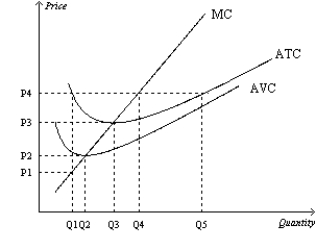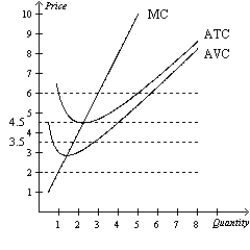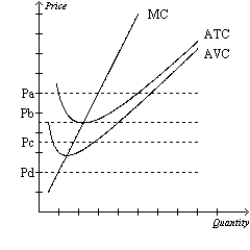B) False
Correct Answer

verified
Correct Answer
verified
Multiple Choice
The long-run supply curve for a competitive industry may be upward sloping if
A) there are barriers to entry.
B) firms that enter the industry are able to do so at lower average total costs than the existing firms in the industry.
C) some resources are available only in limited quantities.
D) accounting profits are positive.
F) A) and D)
Correct Answer

verified
Correct Answer
verified
Multiple Choice
Which of the following represents the firm's short-run condition for shutting down?
A) shut down if TR < TC
B) shut down if TR < FC
C) shut down if P < ATC
D) shut down if TR < VC
F) A) and C)
Correct Answer

verified
Correct Answer
verified
Multiple Choice
The competitive firm's long-run supply curve is that portion of the marginal cost curve that lies above average
A) fixed cost.
B) variable cost.
C) total cost.
D) revenue.
F) A) and D)
Correct Answer

verified
Correct Answer
verified
Multiple Choice
If a firm in a perfectly competitive market triples the quantity of output sold, then total revenue will
A) more than triple.
B) less than triple.
C) exactly triple.
D) Any of the above may be true depending on the firm's labor productivity.
F) All of the above
Correct Answer

verified
Correct Answer
verified
Multiple Choice
The long-run supply curve for a competitive industry
A) may be horizontal if entry into the industry lowers average total cost.
B) may be upward-sloping if higher-cost firms enter the industry.
C) will be horizontal if there is free entry into the industry.
D) will be upward-sloping if there are barriers to entry into the industry.
F) A) and C)
Correct Answer

verified
Correct Answer
verified
True/False
In the short run, if the market price is below the firm's average total cost of production, the firm will always shut down.
B) False
Correct Answer

verified
Correct Answer
verified
Multiple Choice
Scenario 14-4 The information below applies to a competitive firm that sells its output for $40 per unit. • When the firm produces and sells 150 units of output, its average total cost is $24.50. • When the firm produces and sells 151 units of output, its average total cost is $24.55. -Refer to Scenario 14-4. Suppose the firm is producing 150 units of output and its fixed cost is $975. Then its variable cost amounts to
A) $2,360.25.
B) $2,500.00.
C) $2,612.75.
D) $2,700.00.
F) A) and C)
Correct Answer

verified
Correct Answer
verified
True/False
When an individual firm in a competitive market increases its production, it is likely that the market price will fall.
B) False
Correct Answer

verified
Correct Answer
verified
Multiple Choice
Figure 14-4
Suppose a firm operating in a competitive market has the following cost curves:  -Refer to Figure 14-4. When price falls from P3 to P1, the firm finds that it
-Refer to Figure 14-4. When price falls from P3 to P1, the firm finds that it
A) decreases its fixed costs.
B) should produce Q1 units of output.
C) should produce Q3 units of output.
D) should shut down immediately.
F) A) and C)
Correct Answer

verified
Correct Answer
verified
True/False
Firms operating in perfectly competitive markets try to maximize profits.
B) False
Correct Answer

verified
Correct Answer
verified
Multiple Choice
Figure 14-13
Suppose a firm in a competitive industry has the following cost curves:  -Refer to Figure 14-13. If the price is $6 in the short run, what will happen in the long run?
-Refer to Figure 14-13. If the price is $6 in the short run, what will happen in the long run?
A) Nothing. The price is consistent with zero economic profits, so there is no incentive for firms to enter or exit the industry.
B) Individual firms will earn positive economic profits in the short run, which will entice other firms to enter the industry.
C) Individual firms will earn negative economic profits in the short run, which will cause some firms to exit the industry.
D) Because the price is below the firm's average variable costs, the firms will shut down.
F) All of the above
Correct Answer

verified
Correct Answer
verified
Multiple Choice
Mrs. Smith operates a business in a competitive market. The current market price is $8.10. At her profit-maximizing level of production, the average variable cost is $8.00, and the average total cost is $8.25. Mrs. Smith should
A) shut down her business in the short run but continue to operate in the long run.
B) continue to operate in the short run but shut down in the long run.
C) continue to operate in both the short run and long run.
D) shut down in both the short run and long run.
F) A) and D)
Correct Answer

verified
Correct Answer
verified
Multiple Choice
Laura is a gourmet chef who runs a small catering business in a competitive industry. Laura specializes in making wedding cakes. Laura sells 20 wedding cakes per month. Her monthly total revenue is $5,000. The marginal cost of making a wedding cake is $200. In order to maximize profits, Laura should
A) make more than 20 wedding cakes per month.
B) make fewer than 20 wedding cakes per month.
C) continue to make 20 wedding cakes per month.
D) We do not have enough information to answer the question.
F) B) and D)
Correct Answer

verified
Correct Answer
verified
Multiple Choice
Roger owns a small health store that sells vitamins in a perfectly competitive market. If vitamins sell for $12 per bottle and the average total cost per bottle is $11.50 at the profit-maximizing output level, then in the long run
A) more firms will enter the market.
B) some firms will exit from the market.
C) the equilibrium price per bottle will rise
D) average total costs will rise.
F) A) and C)
Correct Answer

verified
Correct Answer
verified
Multiple Choice
Mrs. Smith operates a business in a competitive market. The current market price is $8.50. At her profit-maximizing level of production, the average variable cost is $8.00, and the average total cost is $8.25. Mrs. Smith should
A) shut down her business in the short run but continue to operate in the long run.
B) continue to operate in the short run but shut down in the long run.
C) continue to operate in both the short run and long run.
D) shut down in both the short run and long run.
F) B) and D)
Correct Answer

verified
Correct Answer
verified
True/False
For firms operating in a perfectly competitive market, price must always be greater than marginal revenue.
B) False
Correct Answer

verified
Correct Answer
verified
Multiple Choice
Figure 14-2
Suppose a firm operating in a competitive market has the following cost curves:  -Refer to Figure 14-2. Which of the four prices corresponds to a firm earning negative economic profits in the short run but trying to remain open?
-Refer to Figure 14-2. Which of the four prices corresponds to a firm earning negative economic profits in the short run but trying to remain open?
A) Pa
B) Pb
C) Pc
D) Pd
F) None of the above
Correct Answer

verified
Correct Answer
verified
True/False
Suppose a firm is considering producing zero units of output. We call this exiting an industry in the short run and shutting down in the long run.
B) False
Correct Answer

verified
Correct Answer
verified
Multiple Choice
Suppose that a firm operating in perfectly competitive market sells 300 units of output at a price of $3 each. Which of the following statements is correct? (i) Marginal revenue equals $3. (ii) Average revenue equals $3. (iii) Total revenue equals $900.
A) (i) only
B) (iii) only
C) (i) and (ii) only
D) (i) , (ii) , and (iii)
F) A) and B)
Correct Answer

verified
Correct Answer
verified
Showing 501 - 520 of 604
Related Exams